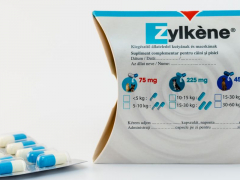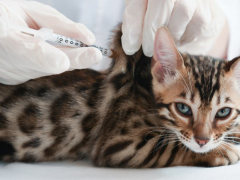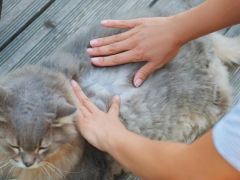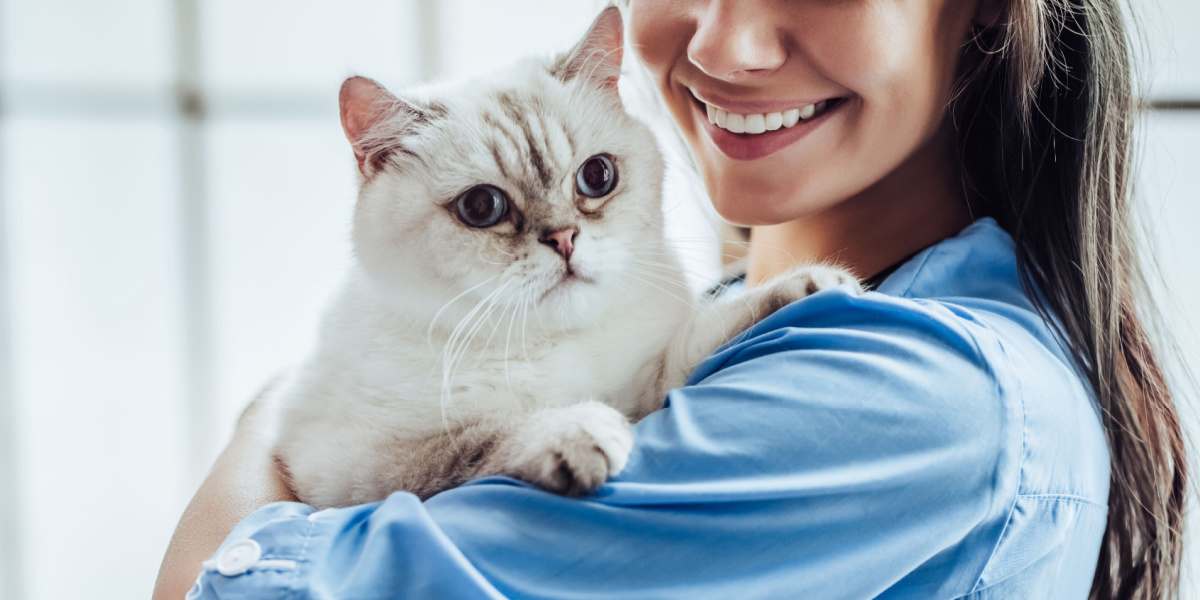
Buprenorphine is one of the most common analgesic pain medications prescribed for cats, especially for short term use following a procedure or painful injury.
Buprenorphine For Cats Overview

In this article, you’ll learn more about buprenorphine, how it’s used, and effects it causes in kitties.
What Is Buprenorphine for Cats?
Buprenorphine is what is called a partial mu-opioid agonist. What does this mean?
Opioid drugs are simply those that can bind to opioid receptors throughout the body. There are four recognized opioid receptors throughout the body most of which have Greek letter designations: mu, kappa, delta, and opioid-like receptor 1 (ORL-1).
Individual opioid drugs can bind to these receptors differently. Some have a strong affinity for the mu receptor and less affinity for kappa, for example. A full agonist means that the drug binds to the particular receptor very tightly. A partial agonist binds less tightly.
This does not mean that a partial agonist is “weaker” than a full agonist. In fact, at certain doses, we can see similar effects of pain relief. But at higher doses, a full agonist will have more pain relief activity, whereas a partial agonist’s pain relief effect plateaus, and we can instead see more adverse effects.
But at appropriately prescribed doses, a partial mu-opioid agonist like buprenorphine generally demonstrates fewer adverse effects than a full mu agonist like morphine or fentanyl. In most animals buprenorphine is not as effective for pain relief as other opioid drugs, but cats seem to have a special affinity for it, making it a very common pain relief option for them.
Also Read: What Can You Give A Cat For Pain? 6 Vet-Recommended Options
What Does Buprenorphine Do for Cats?
Buprenorphine is used primarily for pain control in cats. Compared to other opioid medications, cats appear to get better pain relief from buprenorphine than other animal species, while keeping the typical side effects seen with most opioids low.
Some examples of situations where buprenorphine is used include surgical procedures like spays and neuters, dental procedures involving tooth extraction, painful injuries like bite wounds or other trauma, and urinary tract conditions causing pain and difficulty urinating collectively known as feline lower urinary tract disease (FLUTD).
The Different Forms of Buprenorphine for Cats
In the veterinary medicine setting, only a liquid form of buprenorphine is typically used. However, liquid buprenorphine does come in three main different preparations.
The first is Buprenex, which is a brand name for the most standard formulation of buprenorphine used in both human and veterinary medicine.
When used in cats, Buprenex is versatile in that it can be given as an injectable at the veterinary clinic, but the same form can also be given by a special route called the buccal or oral transmucosal (OTM) route.
The oral transmucosal route means that Buprenex can be very readily absorbed by the oral tissues inside a cat’s mouth, especially under the tongue or pouches of the cheeks.
This can be a very attractive administration route for kitty parents at home, because this means a cat doesn’t have to actually swallow the medication. As long as it gets in the mouth, a majority of it is typically absorbed.
This absorption route more specific to cats provides a comparable level of pain relief to the injectible routes, though the time to peak effectiveness may take a little longer.
This form typically provides about 12 hours of pain relief for cats, though some vets may prescribe it for every 6 or 8 hours depending on the patient and circumstances.
The second form of buprenorphine is a product called Simbadol, which is labeled specifically for cats. Simbadol is a higher concentration of buprenorphine and when injected under the skin by a veterinarian, can last for up to 24 hours. It can be given off-label by other routes as well including the buccal/OTM route, but will then have a duration that’s much shorter and comparable to Buprenex.
The third form is a patented compounded formulation by ZooPharm called Bup SR. Bup SR can only be given as an injection under the skin by a veterinarian, but can provide pain relief for up to 48 hours.
Side Effects Of Buprenorphine
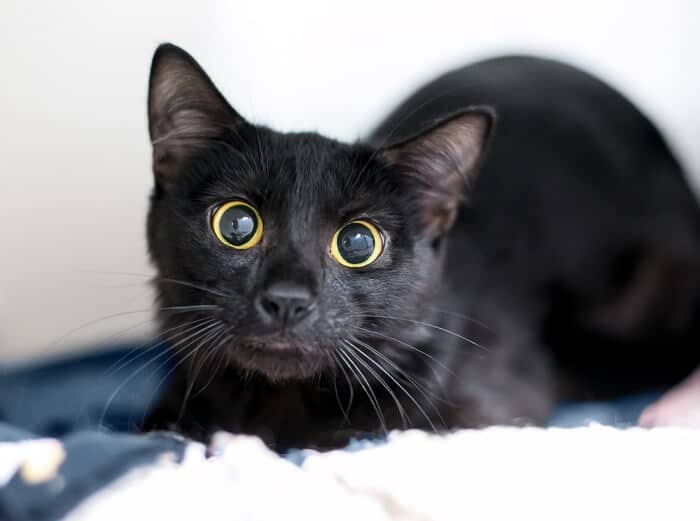
Cats’ pupils often become very dilated after treatment with buprenorphine. They may also exhibit behavioral changes like increased purring, rubbing on things, and hyperactivity.
There are some common side effects we may expect to see with buprenorphine in cats. Typically, their pupils get very dilated, which is an effect called mydriasis. Most cats will then also exhibit some behavioral changes including excessive purring, rubbing on things, pacing around, and hyperactivity.
These effects are typically mild, manageable, and even a little humorous, as your precious feline becomes overly lovey-dovey and tries to rub his head and neck on everything in sight.
In uncommon cases, these effects can be more pronounced leading some cats to become more agitated, disoriented, and restless. Rarely, some kitties may also exhibit gastrointestinal signs like vomiting, drooling, a decreased appetite, and an elevated body temperature.
Buprenorphine can also cause sedation in some cats, causing them to do little more than space out on their favorite spot on the couch or bed at home.
While more an effect veterinary professionals monitor for when buprenorphine is given as an injectable in the clinic, it is important to monitor for signs of respiratory depression, especially in the case of an accidental overdose at home. This can look like very slow, shallow breaths.
If any really concerning effects after a dose of buprenorphine are seen or if a mistakenly higher dose or extra dose was given, make sure to call your vet. Most of the time, any adverse effects will wear off with time and your vet may adjust the dosage. If warranted, most vets do carry the opioid drug reversal agent naloxone in the event of a true emergency.
Buprenorphine for Cats: Dosage and Administration
The dosage for buprenorphine can vary widely based on a cat’s weight, the degree of pain or discomfort being treated, and the form of buprenorphine being used. The concentration of Simbadol for example, is about six times greater than Buprenex, meaning that the same volume of liquid given for each form will have very different levels of potency.
This is why only your veterinarian should provide dosing instructions and your cat’s prescription label should be followed exactly. If you have any questions regarding dosage amounts, make sure to give your vet a call.
How To Administer Buprenorphine for Cats
When sent home, buprenorphine will always be given orally with a needle-free oral dosing syringe provided by your vet. The easiest way to administer buprenorphine by the oral transmucosal route is to insert the tip of the oral dosing syringe into the corner of your kitty’s mouth.
This will prompt a cat to open her mouth at which point you squirt the (typically small) volume of liquid into the mouth. Ideally, we aim for under the tongue or the cheek pouch, but as long as it gets in the mouth, a majority of the volume will be absorbed.
Concluding Thoughts on Buprenorphine
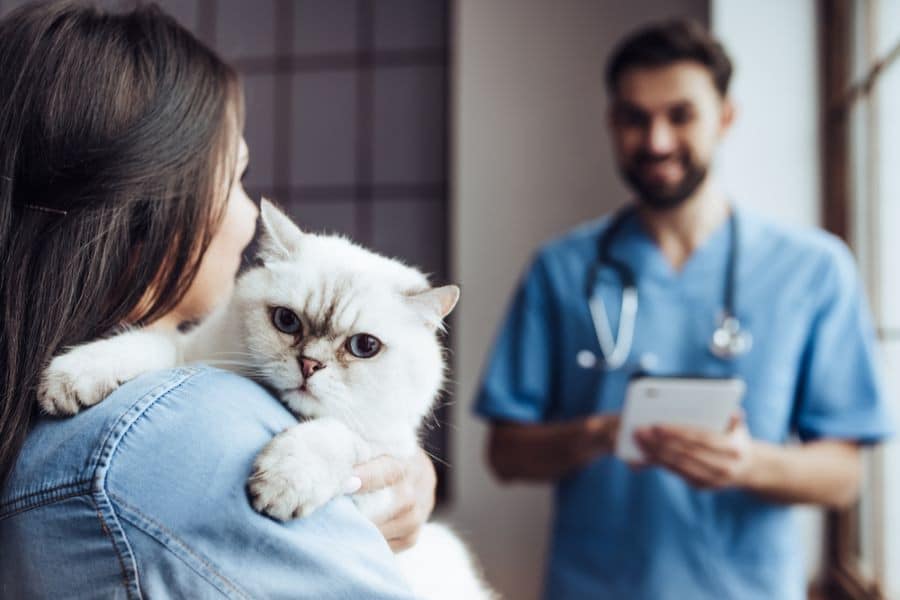
When used properly, buprenorphine can be a safe and effective pain reliever.
When used as prescribed by a veterinarian, buprenorphine is a safe and effective pain reliever in cats.
As a scheduled controlled substance, it does require strict inventory monitoring by vet clinics and there can be severe legal ramifications with misuse. For this reason, an exam is typically required for it to be dispensed and your vet may not allow it to be refilled without a recheck exam.
Buprenorphine is typically used for acute pain and is not given for more than a few days at a time both for economic reasons as well as practicality. Chronic pain conditions in cats are usually managed using different medications, like gabapentin.
Drug Dosing Disclaimer: We are only able to provide doses for medications that are FDA approved for use in cats and only as the label guidelines dictate. For medications that are used off-label we can only provide guidelines and safety information for use. Safe and appropriate dosing for off-label medications can only be determined by a primary care veterinarian.
We encourage you to work with your veterinarian to determine if a particular medication is appropriate for your cat. Changing or adjusting a dose for your cat on your own without consulting with a veterinarian can carry risk. We do not encourage use of medications prescribed for human use in pets without first consulting with a primary care veterinarian.
Frequently Asked Questions
Does Buprenorphine Make Cats High?
In a sense, yes. When opioid drugs bind to opioid receptors, this helps to moderate pain receptors, but can also lead to a state of euphoria, as well as sedation. It is common therefore to see cats on buprenorphine have dilated pupils, and show signs of excessive purring and affection. Some cats will appear to be really “chill” on buprenorphine, while others may become hyperactive.
How Long Can Cats Take Buprenorphine?
Most cats will be prescribed buprenorphine for less than one week, typically about 3-5 days. In some cases, such as for persistent urinary conditions causing pain and difficulty when urinating, buprenorphine may be refilled at your veterinarian’s discretion. One study from the Journal of Veterinary Pharmacology and Therapeutics from 2015 found that high doses of buprenorphine were well tolerated in young cats when given for 9 consecutive days, suggesting that even a full week of buprenorphine at commonly prescribed doses is safe and well tolerated by most cats.
Does buprenorphine for cats need to be refrigerated?
Buprenorphine should be Stored at room temperature between 18°C and 26°C (64°F and 79°F) and protected from direct heat above 42°C (107°F), and freezing
